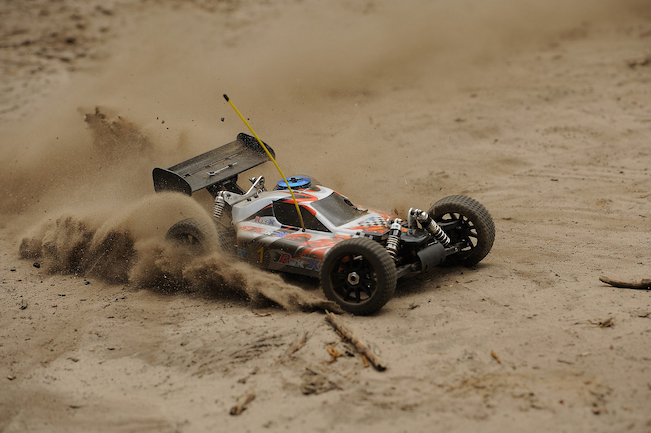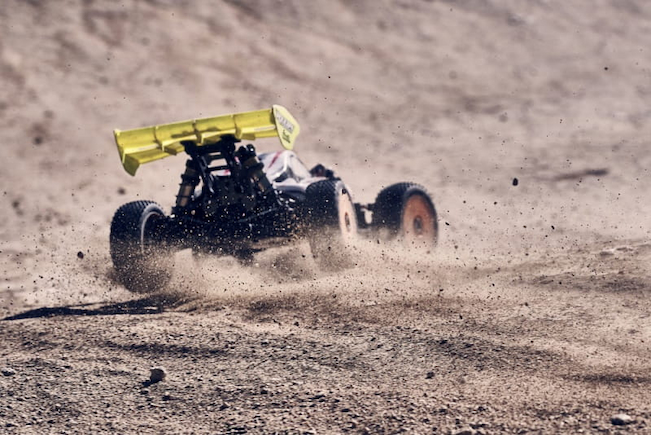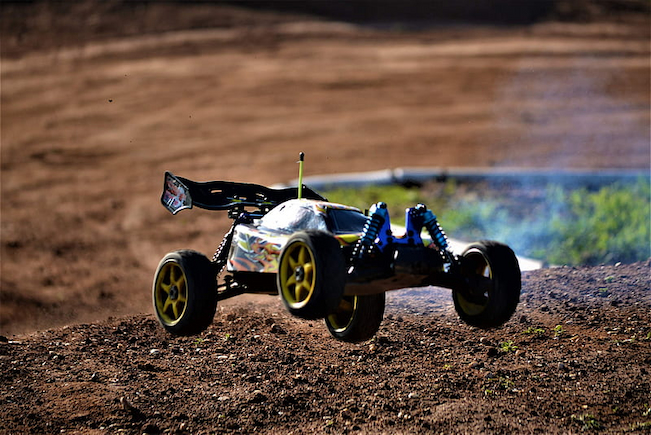Do I buy a nitro or electric RC car? This is one of the first questions you’ll be asking yourself when dipping your fingers in the wide variety of RC vehicles. Both types of cars have their pros and cons, and each type will be geared to different types of hobbyists. There’s undeniably more choice with electric cars, but RC nitro cars have that special something that no brushed or brushless engine can match – realism. Real smoke from a buzzing engine, unique throttle response, and longer run times are just some of the thrills that you won’t find anywhere else.
Basics of Nitro-powered RC Cars

Nitro RC vehicles run on small two-stroke internal combustion engines and burn nitromethane-based fuel (along with methanol and oil) and this is what gives them their name. They use glow plugs (like real diesel engines) to ignite and burn the fuel. The plugs themselves need glow igniters (and some battery power) to get started. These can come packaged with a fully-featured RC nitro car kit, but most often need to be bought separately.
The engine is obviously the largest difference between nitro and electric RC cars. As are related parts, like exhausts, fuel tanks, and the option you have with different fuel ratios, much like racing in real cars. This is the drawing card. And a fun way to build mechanical skills. Yes, you’ll be spending more on general maintenance and replacement parts (worn gear bearings, clogged air filters and faulty glow plugs just to name a few), but the ability to tune your car just the way you like is one of the addictive thrills with this type of RC car.
You’ll still be needing batteries though. These are used to run the radios for the steering and throttle servos, and regular AA batteries for the controller. These are the few common parts between the two types. Some nitro models have an additional servo for the gearing, meaning you can also drive in reverse.
Why Choose Nitro RC Cars Over Electric Variants?

There are quite a few areas where an RC nitro car is better than an electric sibling packaged in the same suit:
- More like the real thing – The smoke and sound from the exhaust as you accelerate are as close as you can get to driving a real rally car or truck. Engines can also reach really high RPMs (some over 50 thousand), and get really loud, despite being only a few CCs in size. Another thing going for nitro is that cars and trucks are often sold in bigger sizes (or scale), so there’s also more attention to detail and life-like parts.
- Longer run times – One tank of nitro fuel can last anywhere between 25 to 30 minutes. And when this is empty, you can throw in a new tank, and continue with the fun. Just remember to stock up on fuel tanks and fuel. Compared to this, the majority of electric cars run out of puff after half an hour, but batteries need 2 to 3 hours of charging time before the next run.
- Higher speeds – While electric cars have all torque available early on and accelerate faster, a nitro car accelerates like a real petrol car, and can reach higher top speeds than most electric cars, despite being heavier and bigger. Some cars can reach over 80 km/h, depending on the engine and the fuel mix. Nitro cars are faster than the majority of electric cars with brushed motors but may fall short of vehicles running the newest brushless motors.
- Better build – The extra weight of the engine, exhaust, fuel tanks, and other parts mean you need a sturdy metal chassis. All nitro RC cars are built around an aluminium chassis and will have metal in areas that matter, like the gears and differentials. They should also last longer, being more water-resistant.
There are a few drawbacks though. There’s more patience needed in maintaining the car in top condition, with a bit of basic mechanical knowledge of how things work. You’ll also be spending more on fuel and replacement parts, but these are easy to find and cheap as well. Lastly, with the noise, smoke and size, these cars aren’t meant for indoor use.
What to Look For

Fuel
With different mixtures, nitro vehicles can be tuned for different levels of performance. This depends on the nitromethane and methanol content. Basic ready-to-race kits will have lower-grade fuel than cars meant for competition racing, with ratios ranging between 15 and 40 per cent. Also, different fuels will vary between different vehicles, for instance between cars and planes.
Scale and Size
The complexity of nitro vehicles means they’re generally bigger. A typical scale size is 1:8, or three to four times as big as cheaper electric models. This means they’ll be more expensive to buy, and limits them to outdoor use.
Brands
The same big-name brands that make electric cars, will also have mid to high-end nitro variants in their lineup. There’s also a whole range of on-road and off-road vehicles to choose from. Companies also sell all the accessories and replacement parts, considering tunability is one of the pros of nitro vehicles. You can find different engines, chassis, and suspension setups, and get all the performance you want.
Final Word
Brushless RC cars might be making big strides in the RC world. but it’s cars and trucks running on nitro that ultimately offer the most fun. Yes, they do take a bit of work, but the high speeds, exceptional realism, and the fact that they can be tuned just how you like mean they’re the vehicles real RC enthusiasts choose.
























